Is the Water Filter You Own or are Buying The Right Water Solution For You
Many people own Water Filters and Water Purifiers that are not suitable or are often not required.
It is important to understand what water filters do. More importantly it is for you to understand what water filter or water purifier you require, If Any!
The Most Common Types of Water Filters Include
- Active Carbon or Charcoal Filters
- Ultra-Violet Sterilization
- Cartridge Filtration
- Reverse Osmosis
- Ion Exchange Resins
- Ceramic Filters
- Combination Units using one or more Water Filtration Technique
Active Carbon or Charcoal Filters
Typical Contents Of Household Filter Cartridge............Electron Microscope View of Pores in Active Carbon
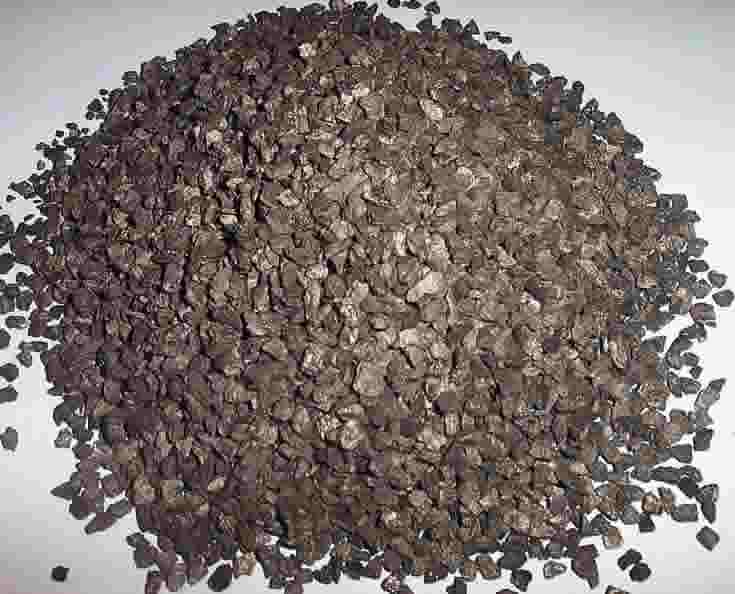
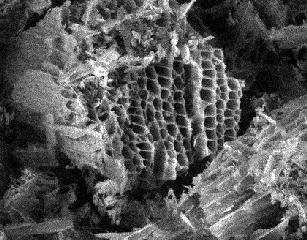
If one looks at the photograph on the left one can see why the other term for Active Carbon is Active Charcoal. The term
"Active" is used to describe carbon's absorbing ability. If the pores become blocked the carbon is no longer active.
If one looks at the Scanning
Electron Microscope picture on the right, the internal surface area of active carbon is generally greater than 400 square meters.
It is on this large available surface area that pollutants like Chlorine, pesticides etc. adhere to the carbon. The longer the contact time between water
and Carbon, the better the removal of water contaminants.
One of the draw backs of Active Carbon is it often becomes a breeding colony for various bacteria over time. One
should ensure that there is post-sterilization, of drinking water if bacteria is a problem in water supply. Some people claim
that impregnating the Active Carbon with Silver prevents Bacteria from passing through the filter. This claim is based on Silver's
anti-bacterial properties. There are both believers and people who have there doubts about Silver impregnation in the water analysis
community.
Did you know your body will absorb more chlorine, in a Ten minute shower through your skin, than it will absorb from drinking 8 glasses of
typical muncipal water
UV Sterilization
UV Sterilization works on the principle that DNA and Proteins absorb UV radiation ( typically around 254 nM ), this causes the bacterial
DNA to denature and renders them inactive.
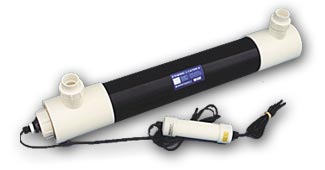
UV supplies a relatively cheap source of Microbial contamination in water, Care must be taken with water that fouls Quartz Sleeve, with
deposits, this prevents UV radiation from reaching water. Regular checking of Quartz sleeve and UV lamp is recommended.
Where high levels of Iron and Manganese are present in water, longer exposure to UV is suggested.
UV filters/sterilizers for drinking
water should have a minimum radiation dose of 30mJ/cm2 at the furthermost point from lamp to ensure bacterial Inactivation. Secondly
ensure lamp has quartz sleeve, if UV lamp is in direct contact with water, and for some reason had to break, not only would you be exposed to
broken glass, but also to Mercury which is typically present in UV discharge lamps.
SMI is one of many Labs worldwide that are researching various Nano-Sized Catalytic Inner coatings to enhance the effect of UV filtration,
by the creation of Hydroxyl Radicals, on the Housings inner-surface. Hydroxyl radicals are more re-active than chlorine, and there breakdown products
are water and carbon dioxide, both of which are harmless. Pesticides and other organic hazardous chemicals are broken down by Hydroxyl radicals.
Reverse Osmosis Filtration
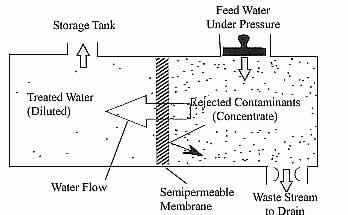
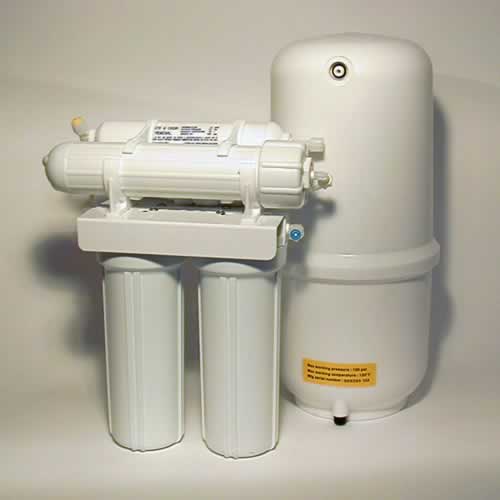
Reverse Osmosis is typically the most effective of your household units if used as a multi-filtration system combining particle filtration and Active Carbon.
If your problems are with dissolved elemental salts in water, RO is the preferred option.
RO units are not normally required with muncipal water systems, as bacterial contamination is most often the problem worldwide, and
although RO units will "reject" bacteria, because of small pore size of membranes, tears and faults as well as manufacturing defects
can allow some contaminants to pass through. No RO unit will provide "pure" water on a typical muncipal water supply. This indicates
that some "contamination" does indeed pass through membranes. And final water polishing stages would be required to ensure "pure" water.
Points to consider are that costly membrane can get easily clogged, beneficial minerals as well as
"possible" water contaminants
are removed. RO units are normally only for one drinking tap and do not cover household water. RO units waste a lot of water, have a look at
flow to drain from RO unit.
Membrane blocking, causing diminished flow into storage tank.............Bacteria on membrane
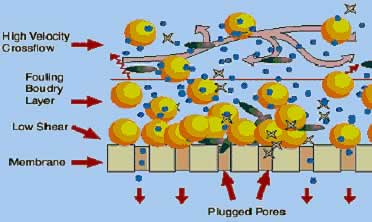

Ion Exchange Resins
These are either mixed bed or consist of separate anion and cation columns.
Usually after RO unit or other water filter to "polish" water to a fairly "pure"
quality.
Some separate column units can be re-generated hundreds of times with an acid and alkaline wash.
They don't produce waste water, but will need regeneration regularly if water contains high total dissolved salts( TDS ).
Ceramic Filters
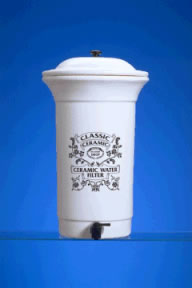
Ceramic water filters if correctly manufactured, have a pore size 0.22 uM or smaller. This prevents bacteria from passing through
filter. Some can be cleaned and might provide the cheapest answer for bacterial free water. However if feed water has suspended particles
present they tend to clog up leading to a diminished water flow. The typical gravity fed system supplies only a few litres per day.
They are often combined with Active Carbon in Filter to provide a improved water filtration system.
Water Information Pages from SMI:
Questions to ask and points to consider before buying a water filter or water purifier.
This page contains useful information on Devious Water Filter Salesmen,
and how to handle them.